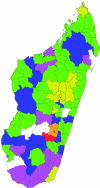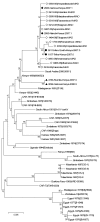Rift Valley fever during rainy seasons, Madagascar, 2008 and 2009
- PMID: 20507747
- PMCID: PMC3086256
- DOI: 10.3201/eid1606.091266
Rift Valley fever during rainy seasons, Madagascar, 2008 and 2009
Abstract
During 2 successive rainy seasons, January 2008 through May 2008 and November 2008 through March 2009, Rift Valley fever virus (RVFV) caused outbreaks in Madagascar. Human and animal infections were confirmed on the northern and southern coasts and in the central highlands. Analysis of partial sequences from RVFV strains showed that all were similar to the strains circulating in Kenya during 2006-2007. A national cross-sectional serologic survey among slaughterhouse workers at high risk showed that RVFV circulation during the 2008 outbreaks included all of the Malagasy regions and that the virus has circulated in at least 92 of Madagascar's 111 districts. To better predict and respond to RVF outbreaks in Madagascar, further epidemiologic studies are needed, such as RVFV complete genome analysis, ruminant movement mapping, and surveillance implementation.
Figures


References
-
- Swanepoel R, Coetzer JAW. Rift Valley fever. In: Coetzer JAW, Thomson GR, Tustin RC, editors. Infectious diseases of livestock. Oxford (UK): Oxford University Press; 2004. p. 1037–70.
-
- Mathiot C, Ribot JJ, Clerc Y, Coulanges P, Rasolofonirina N. Rift valley fever and Zinga virus: a pathogenic arbovirus in man and animal new for Madagascar. Arch Inst Pasteur Madagascar. 1984;51:125–33. - PubMed
Publication types
MeSH terms
Substances
LinkOut - more resources
Full Text Sources
Molecular Biology Databases
